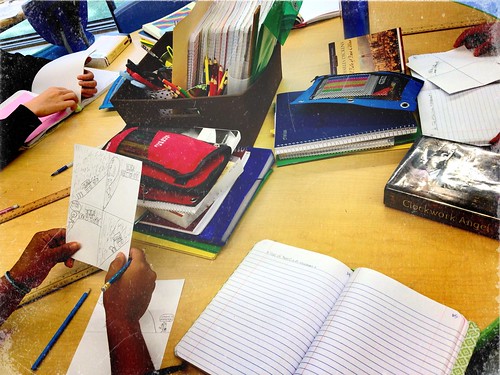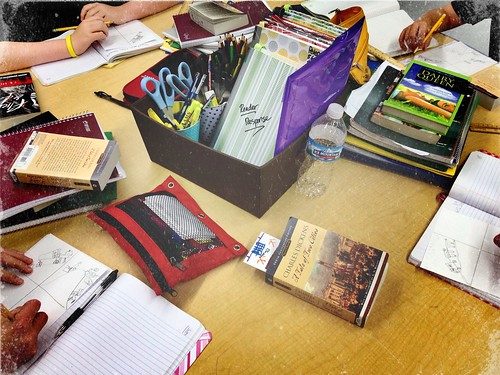Yesterday was the first due date for A Tale of Two Cities. Last week I read the first chapter out loud to the class, and their assignment was to read chapters two and three (about ten pages) on their own and post any questions to me via edmodo. I emphasized that questions could be extremely basic and include the phrase "what the heck is going on?" Here are some sample responses:
 |
| Normally I don't accept this kind of spelling, but it seems fitting here. |
 |
| I like the ALL CAPS RAGE FONT. |
 |
| There are always a few who like it from day one. |
At this point, I really emphasize with students that I want them to keep reading even when the reading is difficult. I want them to practice getting something from the text, even if what they get is "I don't know what's going on!" What I don't want them to do is turn to an online summary for canned answers. I want them to know that they can do this with my help.
This summer I got to hear Terry Thompson (Adventures in Graphica) speak at the All Write Summer Institute in Warsaw, Indiana. One thing I wanted to add this year was a piece of post-reading and discussion reflection. This slide gave me the idea to use drawings after we work on an installment in class.
 |
| Yup, talking about books in the band room. |
After discussion yesterday (I use the word discussion generously), I handed out white drawing paper, cut to 6 by 8 inches, and told the students to divide the paper into four boxes. In each box, I said, we would draw part of the story. We brainstormed a few ideas (mud, horses, a messenger), and they were off.
As always, my students amaze me.
I was shocked by the lack of complaining. After a few jokes about the difficulty of drawing a horse, they all got busy. There was chatter at each table, but the talk was about the book and their drawings. One student even drew the famous opening lines ("It was the best of times, it was the worse of times. . . "). I asked them to add some color, and they did, using the colored pencils at each table. When I mentioned that we might do something like this each week, someone even said "This was fun!"
That is not the typical reaction to the start of our work with A Tale of Two Cities.
Something I don't want is for this to become language arts and crafts. I think stick figure mental images help us avoid this. They don't get graded on their drawings. I think giving them ten minutes in class to do this had the added benefit of a social component. I love the idea that they can refer back to visual notes when they try to remember what happened earlier in the story. I think that next week we'll do character sketches, so every week won't be exactly the same. I like that I'm asking them to do something different before and after.
And, of course, I do what they do. Somehow, I don't think my drawings will be winning any awards any time soon.
 |
| I especially like my stick figure horses. |






Lea -- So much to love here! First of all, I like the low-pressure approach to a book that gives me fits as a reader. You give permission to say, "Huh?" That will help many young readers.
ReplyDeleteThe drawing activity is masterful. When those readers go back to A Tale of Two Cities after processing it through their pictures and those of their classmates and teacher, they will have more to latch onto, and more modes to draw from.
Thanks for sharing this success story.
Gary
Thanks, Gary. I'm really liking the pictures.
Delete